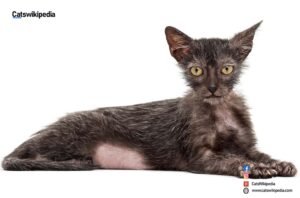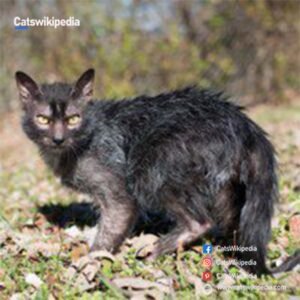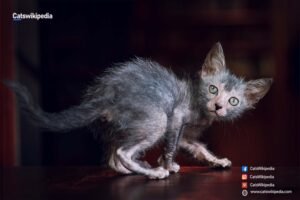LYKOI CAT BREED
LYKOI CAT BREED: AN INTRODUCTION1
The Lykoi (pronounced “lie-koi”) is wild at heart and active on self-assigned works—not sitting lazily over the lap. If you are lucky enough to glimpse the Lykoi, which is pretty rare, you could easily mistake them for a miniature werewolf. In fact, “Lykoi” approximately translates as “wolf cat” in Greek.
Except for their hairless body, Lykoi cat breed is about the same size and weight as most other small—to medium-sized cat breeds. They reach a height of 8 to 10 inches and average 6 to 12 pounds.
The Lykoi breed is a uniquely looking cat that is, for the most part, hairless and developed from spontaneous mutations. It has a roan coat pattern composed of mixed colorful and white body hairs, with the face, tail, and legs mainly in solid color; its fur can appear harsh but is actually soft. Lykoi cats are pleasant to touch as their fur grows in patches and lacks an undercoat.

At most, I’d describe them as werewolf cats with hypotrichosis, a congenital condition that causes them to appear half-bald. According to his theory, Lykoi cats have fewer follicles per hair follicle group than other house cats, resulting in fragile hair.
Lykoi cat breed, like the almost-hairless Sphynx, require a diet of proper nutrition and occasional baths to prevent greasy skin. They appear to lose less hair than the majority of other cats. Seasonal. But buyer beware: Lykoi cats do molt and can go almost hairless on rare occasions—a condition affectionately dubbed “wolfing out.”
HISTORY OF LYKOI
The unique Lykoi cat breed was founded in 2011 by veterinarian Johnny Gobble. According to the Atreyukatz Cattery, Gobble was cautious in establishing the breed; he researched the founder kittens (from different litters) for infectious infections and abnormalities and gave a complete cardiac assessment for each one. According to the cattery, he also responded quickly and cooperatively with geneticists from the University of California, Davis, and dermatologists based at the University of Tennessee to rule out any health issues related to the breed.
Lykoi cats, for the most part, are reasonably healthy and have an average depth of 12 to 15 years due to Gobble’s careful breeding practices. Due to their atypical coat, Lykoi cat breed is more prone to common health conditions, including most domestic cat health ailments. Thus, Pet insurance might prove helpful for your Lykoi cat. Agonistic Fading.
GENETICS OF LYKOI
According to research conducted by UMSL, lymphocytic mural folliculitis is a disease associated with reduced hair follicles in cats with Lykoi skin. In normal coated cats, the disease is mainly associated with allergic reactions caused by various factors.
Cats with lymphocytic mural folliculitis can develop crusted and scaly skin on their heads, necks, and stomachs. Ulcers can also develop on a cat’s lips and eyelids, and their paw pads are often dry and can crack. If you observe these or other skin anomalies, you can consult with your veterinarian because, in such conditions, a diagnosis can be made.

Every cat has a potential problem with dental diseases, which will undoubtedly cause bad breath, painful biting, and tooth loss. The best ways to avoid dental issues with your cat are to wash their teeth regularly and to engage a veterinarian for inspection.
WHAT TO FEED A LYKOI?
Lykoi cats and kittens should be fed cat food with the nutritional needs outlined by the Association of American Feed Control Officials (AAFCO) for the animal’s life stage. Lykoi kittens should be fed a kitten formula. Kittens should be switched to adult food at one year of age. Lykoi kittens may be free-fed several times per day at the exact times. Adult cats should be fed small meals twice a day or more.
If your Lykoi is eating too fast or needs mealtime enrichment like most cats, try offering a few meals or even just snacks with a food puzzle, lick mat, or slow feeder.
Other activities for Lykoi Cats include:
- Perch on high-up cat towers or shelves.
- Discover New Areas of the House
- Stalk their toys, people, or other pets.
- Interactive Play with Toys
- Toy Fetch
- Solve Food Puzzles
- Sleep behind the covers on the bed.
- Sunbathe (though with sun protection).
- Lounge in their favorite bed.
PET PARENT TIPS
Lykoi cat breed thrive in high-energy and adventurous environments, as the breed is known for significant energy and inherent curiosity. This distinctive appearance also comes with some necessary care, including the responsible owner not being surprised if their Lykoi mounts its entire coat occasionally and needs an occasional bath with gentle, cat-friendly shampoo.
As affectionate and social as Lykoi cat breed is with most families, those with young children or other animals should be careful with their pronounced prey drive. Daily active playtime and a little mental enrichment will keep these curious cats content.

LYKOI’S FAQS
1-Why do they call Lykoi a “wolf cat” or “Werewolf Cat”?
Lykoi derives from the Greek word for wolf: “lycos” or “lykus,” which fits the animal’s appearance. Lykoi cat breed are primarily hairless, will have the roan coat pattern, and have very short fur; the fur grows in patches and does not have an undercoat, giving the appearance of being that little werewolf. Lykoi cats shed their whole coat, which the breed’s creators lovingly call “wolfing out.”
2-Are Lykoi Cat’s high Maintenance?
Lykoi cats breed requires special attention to their coat and skin. Despite being hairless, they still need to be combed daily or once weekly to remove any free hair lying on the body and prevent it from tangling. The skin should be regularly checked for dryness, redness, and sunburn.
3-What is the cost of a Lykoi Cat?
The prices of Lykoi cat breed is typically at $1,000 and above.


